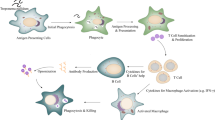Abstract
The cell-mediated response in BALB/c mice infected either by Trichinella pseudospiralis or Trichinella spiralis was compared at days 30–50 post-infection (muscle phase). The former species is non-encapsulated, whereas the latter is encapsulated in host muscles. The pattern of response against the two species was similar. Both species elicited TH0 or TH1/TH2 response, with the last one being dominant. Productions of interferon gamma (IFN-γ), interleukin (IL)-4 and IL-5 were observed after antigenic restimulation of splenocytes from infected mice. No significant difference was observed between the levels of response to concanavalin A (Con-A) by the splenocytes from both infected and non-infected animals. There was a significant increase in serum IgG1 and IgG2a. Flow cytometric analysis revealed a marked proliferative response of splenocytes from infected mice to worm antigens, dominated by B (CD19) lymphoblasts. Only a few helper (CD4+) and cytotoxic (CD8+) T lymphoblasts were present. This was confirmed by an up-regulation of CD69, with a dominant expression on B lymphoblasts. In conclusion, the minimal or lack of intense cellular response against T. pseudospiralis in muscles is likely not due to depression of cell-mediated immunity.





Similar content being viewed by others
References
Bolaz-Fernandez F, Wakelin D (1990) Infectivity, antigenicity and host responses to isolates of the genus Trichinella. Parasitology 100:491–497
Boles LH, Montgomery JM, Morris J, Mann MA, Stewart GL (2000) Suppression of multiple sclerosis in the rat during infection with Trichinella pseudospiralis. J Parasitol 86:841–844
Gabryel P, Gustowska L, Blotna-Filipiak M (1995) The unique and specific transformation of muscle cell infected with Trichinella spiralis. Basic Appl Myol 5:213–222
Grencis RK, Hultner I, Else KJ (1991) Host protective immunity to Trichinella spiralis in mice: activation of Th cell subsets and lymphokine secretion in mice expressing different response phenotypes. Immunology 74:329–332
Hall LR, Lass JH, Diaconu E, Strine ER, Pearlman E (1999) An essential role for antibody in neutrophil and eosinophil recruitment to the cornea: B cell-deficient (μMT) mice fail to develop TH2-dependent helminth-mediated keratitis. J Immunol 163:4970–4975
Harris DP, Haynes L, Sayles PC, Duso DK, Eaton SM, Lepak NM, Johnson LL, Swain SL, Lund FE (2000) Reciprocal regulation of polarized cytokine production by effector B and T cells. Nat Immunol 1:475–482
Helmby H, Grencis RK (2002) IL-18 regulates intestinal mastocytosis and Th2 cytokine production independently of IFN-γ during Trichinella spiralis infection. J Immunol 169:2553–2560
Ishikawa N, Goyal PK, Mahida YR, Li KF, Wakelin D (1998) Early cytokine responses during intestinal parasitic infection. Immunology 93:257–263
Kramer M, Stewart GL, Charniga L (1981) A comparative study of Trichinella spiralis (Owen, 1835) and Trichinella pseudospiralis (Garkavi, 1972). J Parasitol 67:911–916
Larsen E, Stewart GL, Niederkorn JY (1991) Trichinella pseudospiralis overcomes innate resistance of the Chinese hamster to Trichinella spiralis. Parasitology 103:465–470
Lauzurica P, Sancho D, Torres M, Albella B, Marazuela M, Merino T, Bueren JA, Martinex-A C, Sanchez-Madrid F (2000) Phenotypic and functional characteristics of haemotopoietic cell lineages in CD69-deficient mice. Blood 95:2312–2320
Li CKF, Ko RC (2001) Inflammatory response during the muscle phase of Trichinella spiralis and Trichinella pseudospiralis infections. Parasitol Res 87:708–714
Li CKF, Chung YYY, Ko RC (1999) The distribution of excretory/secretory antigens during the muscle phase of Trichinella spiralis and T. pseudospiralis infections. Parasitol Res 85:993–998
Morales MAG, Mele R, Sanchez M, Sacchini D, Giacomo MD, Pozio E (2002) Increased CD8+-T-cell expression and a type 2 cytokine pattern during the muscular phase of Trichinella infection in humans. Infect Immun 70:233–239
Mosmann TR, Sad S (1996) The expanding universe of T-cell subsets: Th1, Th2 and more. Immunol Today 17:139–146
Nagaraju K (2001) Immunological capabilities of skeletal muscle cells. Acta Physiol Scand 171:215–223
Scully R, Cobbold SP, Mellor AL, Wissing M, Arnold B, Waldmann H (1997) A role for Th2 cytokines in the suppression of CD8+ T cell-mediated graft rejection. Eur J Immunol 7:1663–1670
Shupe K, Stewart GL (1991) Stimulated chemotactic response in neutrophils from Trichinella pseudospiralis-infected mice and the neutrophilotactic potential of Trichinella extracts. Int J Parasitol 21:625–630
Stewart GL (1995) Myopathogenesis and myoredifferentiation in trichinosis. Basic Appl Myol 5:213–222
Stewart GL, Larsen E (1989) Infection of the Chinese hamster with Trichinella pseudospiralis. J Parasitol 75:1006–1007
Stewart GL, Mann MA, Ubelaker JE, McCarthy JL, Wood BG (1988) A role for elevated plasma corticosterone in modulation of host response during infection with Trichinella pseudospiralis. Parasite Immunol 10:139–150
Urban JF, Schopf L, Morris SC, Orekhova T, Madden KB, Betts CJ, Gamble HR, Byrd C, Donaldson D, Else K, Finkelman FD (2000) Stat6 signaling promotes protective immunity against Trichinella spiralis through a mast cell- and T cell dependent mechanism. J Immunol 164:2046–2052
Vallance BA, Matthaei KI, Sanovic S, Young IG, Collins SM (2000) Interleukin-5 deficient mice exhibit impaired host defense against challenge Trichinella spiralis infections. Parasite Immunol 22:487–492
Wakelin D, Grencis RK (1992) T cell and genetic control in inflammatory cells. In: Moqbel R (ed) Allergy and immunity to helminths. Taylor and Francis, London, pp 108–136
Wakelin D, Goyal PK, Dehlawi MS, Hermanek J (1994) Immune responses to Trichinella spiralis and Trichinella pseudospiralis in mice. Immunology 81:470–475
Waters WR, Palmer MV, Wannemuehler MJ, Sacco RE, Harp JA (2000) B cells are required for the induction of intestinal inflammatory lesions in TCRα-deficient mice persistently infected with Cryptosporidium parvum. J Parasitol 86:1073–1077
Wu Z, Nagano I, Boonmars T, Takahashi Y (2005) Tumor necrosis factor receptor-mediated apoptosis in Trichinella spiralis-infected muscle cells. Parasitology 131:373–381
Yokoyama M, Hassett DE, Zhang J, Whitton L (1997) DNA immunization can stimulate florid local inflammation and the anti-viral immunity induced varies depending on injection site. Vaccine 15:553–560
Acknowledgements
This study was supported by a research grant from the University of Hong Kong to R.C.K. We are grateful to the invaluable assistance of Mr. W.H. Sit, Ms. H.M. Lun and Ms. Y.Y.Y. Chung.
Author information
Authors and Affiliations
Corresponding author
Rights and permissions
About this article
Cite this article
Lee, K.M., Ko, R.C. Cell-mediated response at the muscle phase of Trichinella pseudospiralis and Trichinella spiralis infections. Parasitol Res 99, 70–77 (2006). https://doi.org/10.1007/s00436-005-0101-z
Received:
Accepted:
Published:
Issue Date:
DOI: https://doi.org/10.1007/s00436-005-0101-z




